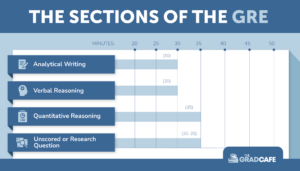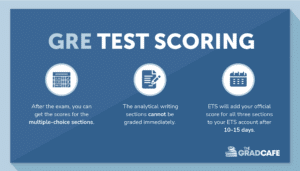How long is the GRE exam? Here’s everything you need to know about the duration of the GRE. In short, expect the new test to take about two hours.
The Graduate Records Examination (GRE) is a standardized test that many US graduate schools use to assess applicants. The test measures verbal reasoning, critical thinking, analytical writing, and quantitative reasoning and takes just under two hours.
Taking the GRE is essential for anyone wanting to pursue further education after getting a bachelor’s degree.
A strong score can help you get into a good school, so preparing for the exam is essential. Knowing what is on the exam and how long the exam will take will help you with time management and give you a leg up over other students taking the test.
This article will tell you everything you need to know about how long the GRE is and how to prepare for the test within the allotted time.
The Short Answer to “How Long Is the GRE?”
The new, shorter GRE lasts for just under two hours, at one hour and 58 minutes. The updated version of the test was introduced in September 2023 and tests the same content with similar types of questions as the old test. It has fewer sections than the old exam and fewer questions overall. There’s also no longer a 10-minute break.
The new GRE is divided into five sections. One written section and four sections cover verbal and quantitative reasoning.
The written section lasts for 30 minutes, while the verbal and quantitative reasoning sections range between 18 and 26 minutes. We’ll go into more detail about what to expect in each section below.
How long it takes to complete each section depends on many factors, including your preparation. While you can’t move ahead to other sections of the exam, taking less than the allotted time on each section gives you an opportunity to check your work, which is an advantage.
If you run out of time, you’ll have unanswered questions, lowering your score. So, it’s essential to manage your time wisely.
To get a better idea of how long the GRE will take, let’s look at the individual sections.
How Long is Each Section of the GRE?

To answer the question of how long the GRE is, we’ll need to consider each portion. Below, I’ll break down the expected time for each section.
The GRE is divided into four sections:
- Analytical writing
- Verbal reasoning
- Quantitative reasoning
- An unscored section
Read on to learn everything you need to know about GRE section time.
Related: What is on the GRE?
Analytical Writing: 30 Minutes
The analytical writing portion involves a written essay based on a prompt provided in the exam. You may be asked to analyze an issue or argument.
You’ll read a statement or claim about a general topic if asked to analyze an issue. You’ll then have to write a response about whether you agree with the statement or claim and to what extent.
You’ll have to explain your reasoning and provide examples or evidence that supports your position.
An example analytical writing prompt that Educational Testing Services provides is: “As people rely more and more on technology to solve problems, the ability of humans to think for themselves will surely deteriorate.”
The goal of this portion of the exam is to determine:
- How clearly and effectively you can articulate complex ideas
- How well you can support your positions with evidence
- Your control of the English language
- Your ability to sustain focused, coherent writing
The written section of the exam lasts for 30 minutes.
Verbal Reasoning: 41 Minutes
The verbal reasoning portions of the GRE general test include three types of questions:
- Reading comprehension
- Text completion
- Sentence equivalence
Reading comprehension questions ask you to read a passage and answer three questions based on the content.
Question types include:
- Multiple-choice questions with one correct answer
- Multiple-choice questions with more than one correct answer
- Questions that ask you to select the sentence within a passage that fits a description
Text completion questions give you a passage with blank spaces. You must then fill in those blanks using words from a given list.
Sentence equivalence questions provide a single sentence with a single blank space. You must choose two words from a list to fill in that blank. The words you choose should mean the sentence makes sense and has the same meaning, regardless of which word you place in the blank.
These questions look to measure your ability:
- To analyze and conclude text, discussions, and incomplete data
- To infer the viewpoints or biases of the author
- To separate important and minor points from the text
There are two verbal reasoning sections: section one lasts 18 minutes, and section two lasts 23 minutes.
Quantitative Reasoning: 47 Minutes
The quantitative reasoning portion of the GRE exam contains four types of questions:
- Comparison questions
- Multiple-choice with one correct answer
- Multiple-choice with more than one correct answer
- Numeric entry questions
Quantitative comparison questions will ask you to compare two quantities and determine which is larger or if they’re the same size. These quantities can be based on algebraic equations and geometry.
For example, you might be asked to decide whether (x2 +1) or (2x – 1) is larger.
Both forms of multiple-choice questions will have you answer questions based on algebra, geometry, or word problems that involve math. These allow you to demonstrate your problem-solving and data-interpretation abilities.
Numeric entry problems are math problems where you must determine and enter the answer manually. There is no list of options that you may choose from.
Multiple-choice or numeric entry questions may also be based on data provided in table or chart form, testing your data analysis skills.
There are two quant sections: the first lasts 21 minutes and the second 26 minutes.
Check out our comprehensive guide to learn more about what’s included in the GRE.
How Long Are the GRE Subject Tests?

A GRE subject test lets students showcase their knowledge in three specific areas: mathematics, physics, and psychology.
The computer-based GRE subject tests are primarily composed of multiple-choice questions, though the number of questions that appear will depend on the subject. The math test, for example, has about 66 questions. Like the general test, each of the GRE subject tests is broken into multiple sections.
The ETS (Educational Testing Service) publishes the exact breakdown of each test on its website, which gives test-takers some opportunity to prepare. The physics and psychology tests were shortened to two hours in September 2023, but the math exam runs for two hours and 50 minutes.
Related: What is a Good GRE Score?
How Long Does the GRE Take To Complete: Test Day Timeline
Now you have a good idea of how many hours the GRE is overall, let’s look at the length of each section and task.
This GRE test day timeline gives you a detailed snapshot of the entire GRE length time:
| Section/Task | Length | Number of Questions |
| Biographical information | 10 mins approx. | N/A |
| Analytical writing | 30 mins | 1 |
| Verbal reasoning (section one) | 18 mins | 12 |
| Verbal reasoning (section two) | 23 mins | 15 |
| Quantitative reasoning (section one) | 21 mins | 12 |
| Quantitative reasoning (section two) | 26 mins | 15 |
| Select schools/programs | 5 mins | Up to four |
| Accept scores | 1 min | n/a |
| Receive scores | 1 min | n/a |
Note that the timing per section depends somewhat on how confident you are with the content and how quickly you move through the questions. As you aren’t allowed to move on to other sections of the exam until the allotted time, if you finish early, you’ll have the opportunity to check your work or review a particularly challenging question.
How Long is the GRE Test at Home?
So, how long is the GRE exam at home? If you take the test at home, the timings are identical to the GRE section times and breaks at the test center. However, you will need to go through some extra security steps before you start the test.
Note that you can’t just do the test anytime. At-home testing is offered by ETS only for specific dates in September, October, and April. Therefore, you’ll need to book an allocated appointment time, which you can do within 24 hours after registering.
Additionally, you can check in online at your scheduled time through the ETS system — ETS will send you a link for this when you register. If you’re running late, you can check in up to 12 minutes after your test appointment time and start the test. Be careful, though — if you fail to check in within 12 minutes of your appointment, ETS will cancel your test, and you’ll lose your test fee.
Once you check in, you’ll need to go through an authentication and security with a proctor to verify your identity and demonstrate that your home environment complies with the security rules. This usually takes about 20 minutes. From there, the test schedule and timings are the same as how long the GRE takes at a testing center.
How Long Does It Take To Score the GRE?

Once you’ve finished taking the GRE, you’ll probably be anxious to get your test score.
One of the great things about the GRE is that you can get your scores for the multiple-choice sections of the exam almost immediately at the test center. The scores you see right away are unofficial because the scoring may be curved based on other test-takers’ performance.
The written portion of the exam cannot be graded automatically, so you can’t view your score for the analytical writing sections immediately.
About eight to 10 days after you finish taking the GRE, ETS will add your official GRE test scores for all three sections to your ETS account. This will let you view your results and print official copies of your score report.
Once you receive your official scores, you can send them to the graduate program or programs you’re applying to.
Related: How Long Does it Take to Get GRE Scores?
How to Prepare for the GRE and Take Less Time on Test Day

Each section of the GRE is timed, meaning you must work fairly quickly while taking the test. You can’t move forward or back between sections, so you can’t change your answers once a section is over.
The faster you can finish each section of the exam, the more time you’ll have to go back and check your work. If you run out of time before finishing a section, you must leave the remaining questions blank.
That means that preparing for the GRE is essential, as good preparation will help you get more answers correct and move through each exam section more quickly.
One of the best GRE prep strategies is to take practice tests.
Practice tests will let you test your knowledge and familiarize yourself with the exam format. The more familiar you are with how the test looks and feels, the easier it will be to take it on exam day. Getting used to using the on-screen calculator ahead of time can also help you to be more efficient on test day.
You can get free GRE preparation materials from ETS, the company that offers the GRE, including practice questions. Preparation materials and practice tests are also available for purchase. Many experts recommend starting test prep two or three months before test day.
GRE Test Day Timing Tips
Follow these GRE timing tips to help you work through the GRE efficiently, optimize your time, and maximize your chances of a winning result:
- Scan the test. Before answering questions, skim all the questions in the section. Then start with the questions you’re most confident with, and leave the trickier ones for last.
- Limit each question to three minutes. As a general rule, don’t spend longer than three minutes on any single question.
- Skip over questions if necessary. If you’re struggling with a particular question and are still not confident with the answer, it may be better to click the mark button and go on to the next one.
- Return to questions later. Answer easy questions first and give yourself time to spend on the more difficult questions. It’s better to complete the questions you feel confident you’ll get right and return to the others later.
- Make educated guesses. If all else fails, make an educated guess and move on — it’s much better than spending too much time on questions you simply don’t know the answer to.
Common Questions About the GRE
Before I wrap up, I wanted to address some of the most common questions I hear from test takers.
Isn’t the GRE a 4-hour Test?
Understandably, many students want to know how long the GRE takes. The old version took 3 hours and 45 minutes to complete. The new version is under two hours. Nice!
How Much Does the GRE Matter?
Ironically, studies show that your performance on the GRE may not be a great predictor of how well you’ll do in a grad program.
How Can I Improve my GRE Score?
We found several test-prep services that can help increase your score on the exam. Check out Magoosh, specifically. We like that they guarantee you’ll earn a better score. Plus, they’re optimized for the new, shorter test.
Final Thoughts
Plan for the test to take a few hours. After all, if you want to pursue an education beyond a bachelor’s degree, you’ll need to complete the GRE first.
Taking the test can be stressful, but with some knowledge of how the test works and how long the GRE is, you can prepare for the exam and give yourself the best chance of earning a good GRE score.
One more thing! Taking the GRE is just one step toward getting a graduate degree. If you need help financing further education, check out our guide on paying for graduate school.
Preparing for grad school? Discover everything you need to know to pass all the necessary tests with our ultimate grad school test guide.
Lisa is a full-time writer specializing in career advice, further education, and personal development. She works from all over the world, and when not writing you'll find her hiking, practicing yoga, or enjoying a glass of Malbec.











